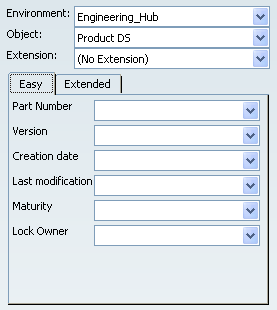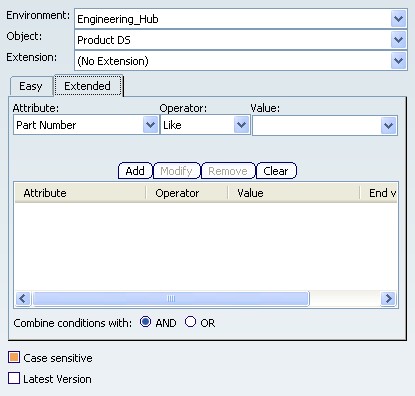Advanced Search - Easy
The following describes the Advanced Search Easy mode.
In the menu bar, select PLM Access > Advanced Search
or, at the bottom-right corner of the Search Results dialog
box, and click Search Criteria, or, in the Bar in the Search box, click the selection arrow and select Advanced Search.
The Search Criteria dialog box appears.
In the Search Criteria dialog box, click the Easy
tab. The Easy search tab appears.

In the Environment list, select an
environment. In the Object list, select an object. In the Extension list, select an extension. For each of the object attributes of type string or
number that you want to use as a
search criteria, enter a value in the corresponding box or, in the
corresponding list, select a value from the list of previously-used
values.
For object attributes of type date, click in the
corresponding box. The Select a date dialog box appears. See
Selecting Dates To render the query case sensitive, select the Case
sensitive check box. To launch the query, click Apply. To launch the query and close the Search Criteria dialog
box, click OK. To close the Search Criteria dialog box without launching
the query, click Close. Important:
- For attributes of type string, the applied condition operator is
"Like".
- For attributes of type date or number, the applied condition
operator is "=".
- In the Easy search, when multiple attribute conditions are
defined, the operator applied between the attribute conditions is
always "AND".
- Query masks are defined by your application Administrator,
therefore some attributes visible in the above screen captures might
not be visible in your application.

Advanced Search - Extended
The following describes the Advanced Search Extended mode, which enables you to define a search with greater precision.
In the menu bar, select PLM Access > Advanced Search
or, at the bottom-right corner of the Search Results dialog
box, click Search Criteria or, in the Bar in the Search box, click the selection arrow and select Advanced Search.
The Search Criteria dialog box appears.
In the Search Criteria dialog box, click the
Extended tab. The Extended search tab appears.

In the Environment list, select an
environment. In the Object list, select an object.
In the Extension list, select an extension. In the Attribute list, select an attribute. In the Operator list, select an operator. Note that:
- no value is associated to operators Null and
Not Null
- two values are associated to ternary operators
Between
and Not Between
- if the Value associated to Like does not have any wildcards "*" , it will be equivalent to operator Equals; if the Value has wildcards before and after the string, then it is equivalent to Contains
In the Value box, enter a value or, in the Value
list, select a value from the list of previously-used values. (For
attribute values of type date, see
Selecting Dates.) Note that:
- for attributes of type String and operator Between, Values are ordered according to the dictionary, e.g. test110 is less than test15 since "1" comes before "5"
To add a condition to the constructed query, click
Add. To modify a condition, select the condition and click
Modify. To remove a condition from the constructed query, select
the condition and click Remove. To remove all conditions from the constructed query,
click Clear. To define the condition operator, click the AND
radio button or the OR radio button. Note: The condition
operator you select is applied between all conditions of the query. To render the query case sensitive, select the Case
sensitive check box. To display only the last version of
all parts corresponding to the search criteria, select the Last
Version Only check box. To launch the query, click Apply. To launch the query and close the Search Criteria dialog
box, click OK. To close the Search Criteria dialog box without launching
the query, click Close.
|
![]()

